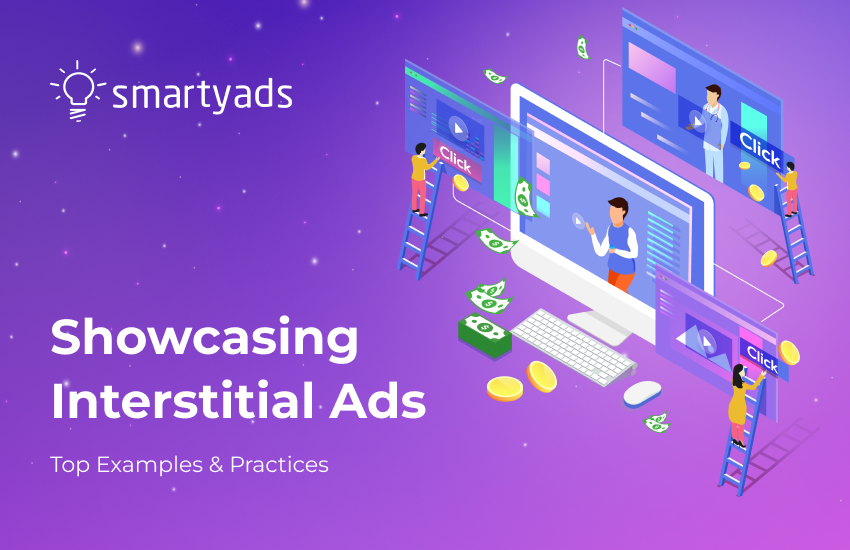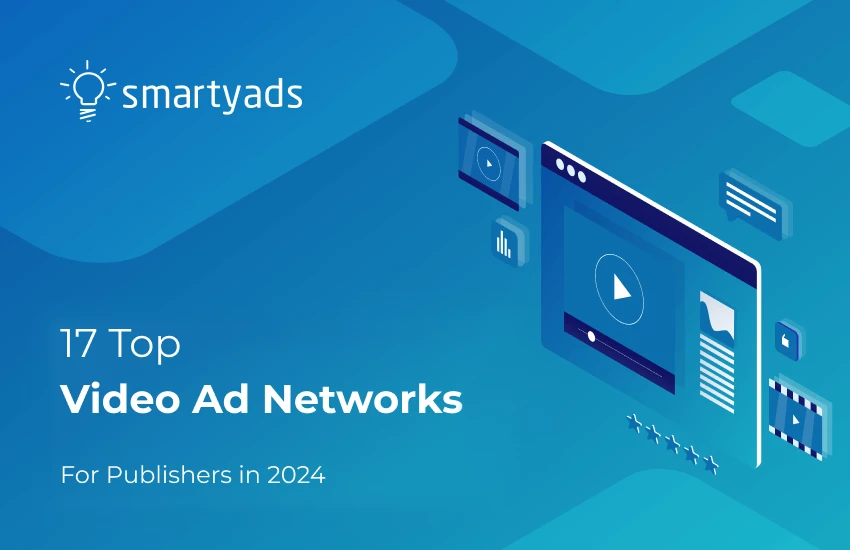Imagine strolling through an enchanting art gallery, appreciating each masterpiece at your own pace. Just as you're about to lose yourself in the world of art, a giant poster suddenly unfolds, obstructing your view and demanding your attention.
This intrusive interruption disrupts the gallery's serene ambiance, leaving you torn between the art you were admiring and the unwelcome intrusion. In the digital world, these gallery-crashing moments are akin to interstitial ads, and we're about to explore their impact, artistry, and how to wield them effectively in the realm of online advertising.
What are interstitial ads?
Interstitial ads, a distinctive form of online advertising, materialize between two content pages, frequently in full-screen pop-ups or overlays. Their primary aim is to seize the user's focus, delivering a message or promotional content before granting access to the intended material. Typically featured on mobile platforms, interstitial advertising encompasses diverse content forms, spanning from promotions and videos to subscription invitations.
Data indicates that the in-app full-screen interstitial advertising has established a notably high effective CPM in various regional markets. This stands as a favorable advantage for publishers.
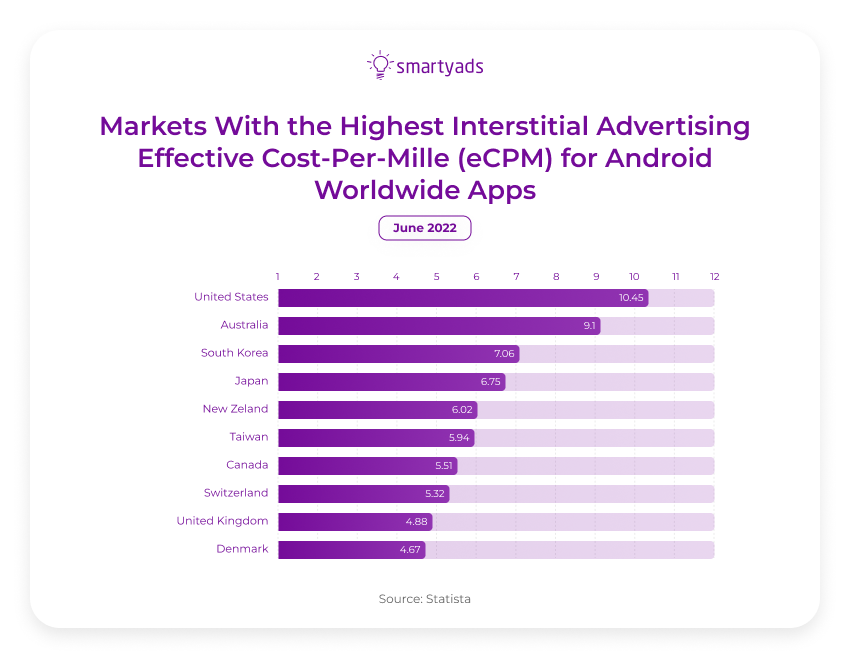
Regarding interstitial ad performance on desktop devices, the eCPM for interstitial ads surpassed banner ads by a staggering 5,173%.
While interstitial ads can be effective for delivering messages, they are also known for potentially interrupting the user experience and can be perceived as intrusive if not used thoughtfully.
Do you know how to make it work better? Here are a few tips.
Interstitial ads are like the gatekeepers of the online world, ushering you into new digital territories. They're not your regular banners or pop-ups; they're grand and bold, commanding your full screen and demanding attention. These digital billboards stand between you and your destination, be it an intriguing article, a thrilling video, or the next level of your mobile game.
Imagine them as the entertainers of the digital circus, suddenly appearing in the middle of your online journey, grabbing the spotlight, and performing their act. They can be in the form of eye-catching visuals, persuasive videos, or interactive prompts. Their mission? To inform, persuade, or guide you before continuing your online adventure.
But just like the performers at a real circus, interstitial ads have garnered both applause and boos. Some find them engaging and effective in conveying messages, while others see them as uninvited guests, disrupting the seamless flow of their online experience.
Implementing interstitial ads into your ad campaigns or platforms can bring a substantial boost to performance. Come with us as we delve into the most effective strategies for harnessing interstitial ads, accompanied by practical examples.
Types of interstitial ads with examples
Full-Screen Interstitials
Taking up the entire screen, these banners often appear when navigating from one content to another.
Full-screen Interstitials are one of the most exciting forms of interstitial ads. They occupy the user's entire screen, making it impossible to ignore the advertising message. These banners are thoughtfully positioned at organic transition junctures between mobile apps and websites, ensuring a seamless user experience without disruptions.
For example, when using the Booking.com app to search for accommodations, you may encounter full-screen interstitial ads offering discounts on flight bookings or showcasing dreamy vacation destinations like "Save 15% on Your Next Getaway."
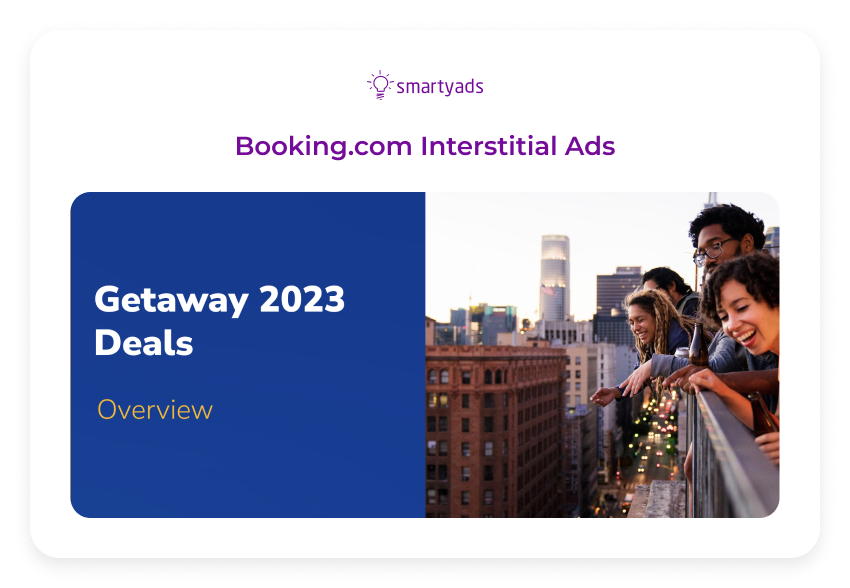
Video Interstitials
Interstitial video ads use short video clips to convey messages or promotions. For instance, YouTube displays interstitials that play before a selected video, showcasing movie trailers or product advertisements.
These ads can range from showcasing upcoming movie trailers and product launches to educational content. For instance, when you're about to watch a travel vlog, you might see a brief interstitial ad for a travel booking website or a video game teaser.
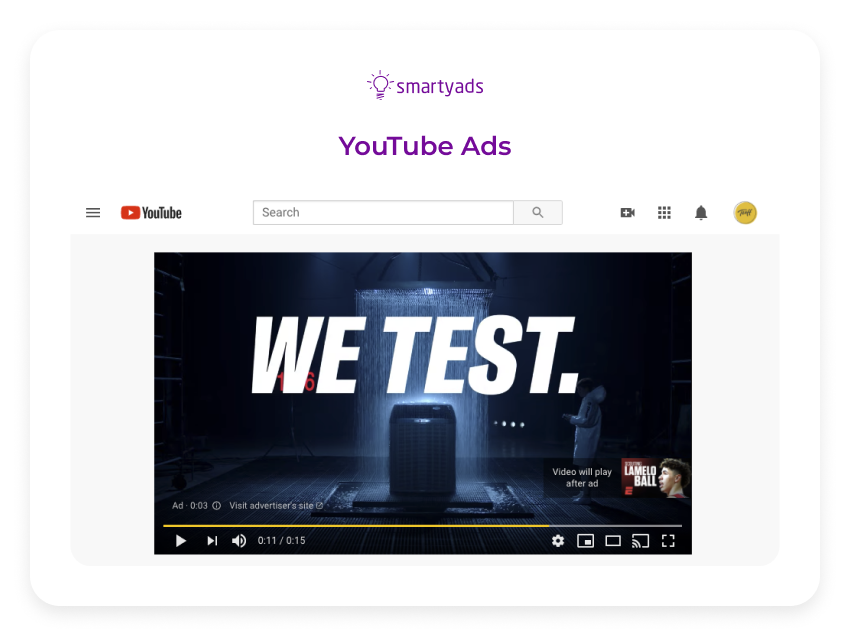
Interactive Interstitials
These ads encourage user engagement. Advertisers can integrate interstitial ads on a news website, where users can interact and provide feedback while the site gathers valuable data.
Interactive Interstitials are a dynamic form of advertising that thrives on fostering user participation and engagement, offering an innovative approach that goes beyond mere ad display.
These ads are designed to provide a two-way communication channel, enabling users to actively participate and provide feedback while the platform simultaneously gains valuable insights.
SurveyMonkey, an online survey platform, often uses Interactive Interstitials to collect user feedback and engage their audience. When you visit their website, you might encounter an Interstitial that invites you to participate in a short survey.
These surveys could be about various topics, such as user experience, product preferences, or current events.
Engaging in the survey empowers SurveyMonkey with invaluable data that fuels service enhancement and provides valuable insights to their clientele. This interactive method not only collects data but also enriches user involvement, paving the way for customized services that cater to individual user needs.
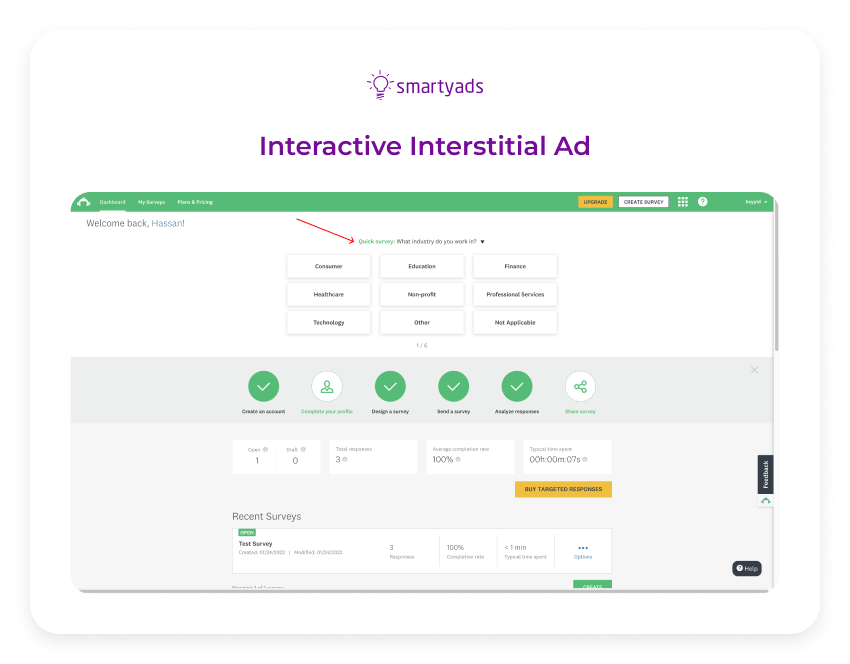
Exit Intent Interstitials
Exit Intent Interstitials are a clever marketing strategy that deploys pop-up banner ads just as a user is about to exit a webpage.
These interstitial ads work like the friendly shopkeeper who offers you an irresistible discount just as you're about to leave the store empty-handed. E-commerce websites, in particular, have harnessed the power of Exit Intent Interstitials to recapture wavering shoppers and increase conversion rates.
Imagine you're shopping online and adding a few items to your cart. However, something distracts you, and you decide to close the browser tab without completing the purchase. That's when Exit Intent Interstitials come into play.
Here's how they work:
Abandoning the Cart
As you move your cursor toward the close button or the back button, the Exit Intent Interstitial springs into action.
Last-Minute Offer
A well-designed pop-up appears, offering a last-minute incentive to stay and complete your purchase. This could be a discount code, free shipping, or a complementary product.
Decision Time
Faced with this tempting offer, you have to decide whether to proceed with your purchase or leave.
For example, the short pop-up ads on the Coursera website. This banner thanks the user for their visit, and the interstitial ad exit button asks if they can participate in a short survey. This type of interstitial ad works because it is an unobtrusive, interactive, user-friendlier experience for the user.
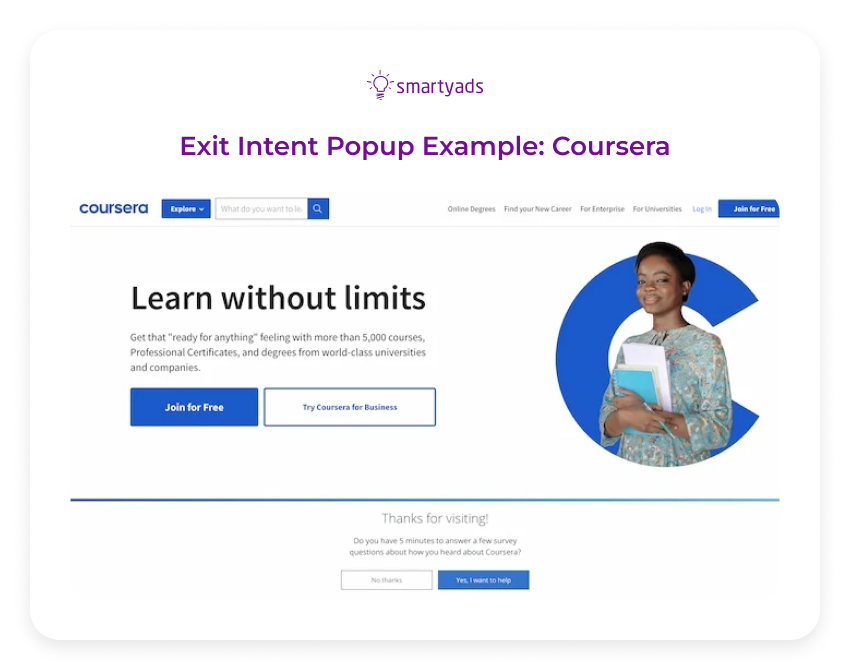
Mobile Interstitial Ads
Mobile apps frequently use interstitials as transition points. For instance, a weather app may display an interstitial ad between weather updates, promoting a travel app. Also, mobile interstitial ads can be used on mobile web as transitional banners between pages of mobile site.
Mobile Interstitial Ads have become a ubiquitous sight for smartphone users, especially within mobile apps. This mobile advertising is cleverly inserted during natural transition points, often making them more acceptable and less intrusive advertising.
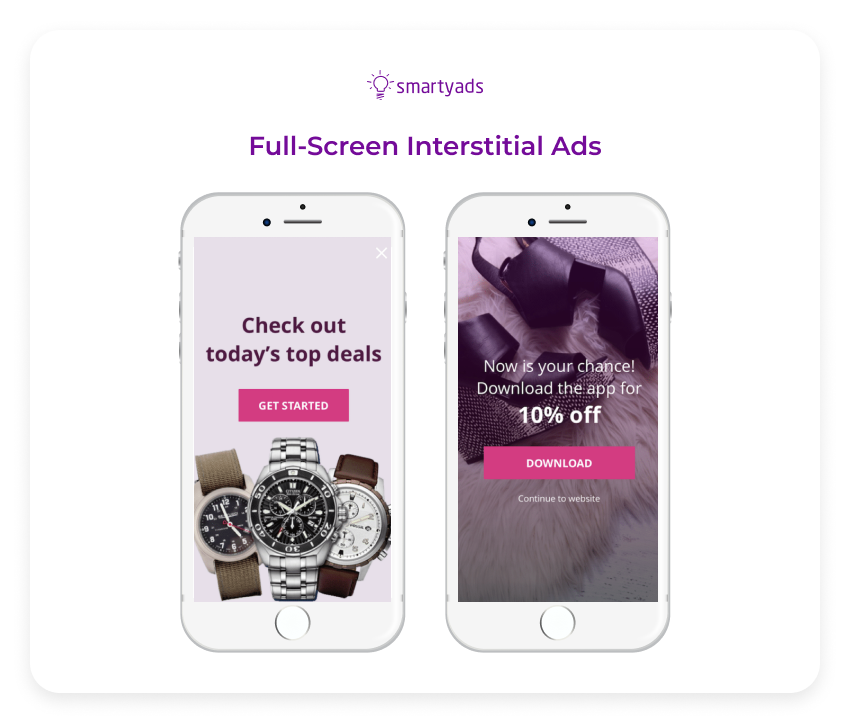
Interstitial Ads in Gaming
Interstitial Ads in the gaming world have become a common sight for players. These ads are strategically placed between game levels, transitions, or natural breaks, often offering rewards, promoting in-app purchases, or showcasing other games.
One of the most common uses of interstitial ads in gaming is to provide players with rewards. Imagine playing your favorite mobile game, and after completing a challenging level, an interstitial ad pops up, offering you in-game currency, extra lives, or power-ups in exchange for watching the ad.
Game developers frequently use interstitial ads to promote in-app purchases. For example, in Candy Crush, players might encounter an interstitial ad that tempts them with exclusive deals on power-ups, extra moves, or boosters. Banner ads are usually placed to capture players' attention when they might be seeking an edge in the game.
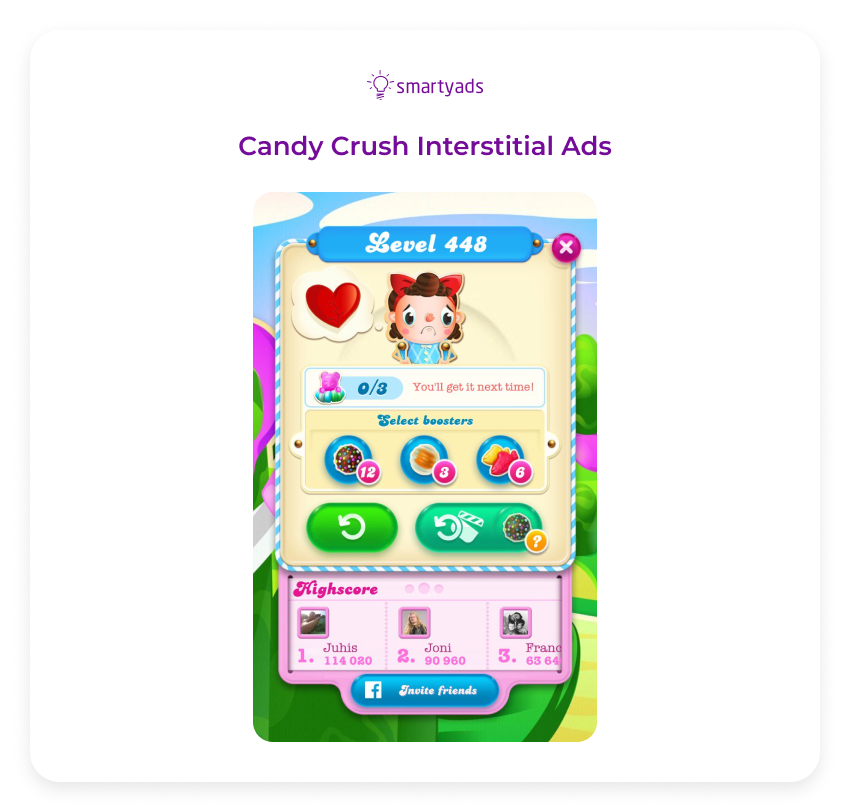
Interstitial ads also serve as a platform for cross-promoting other games from the same developer or gaming studio. When you're deeply involved in one game, an interstitial ad may introduce you to another game created by the same company, sparking your interest in a new gaming adventure.
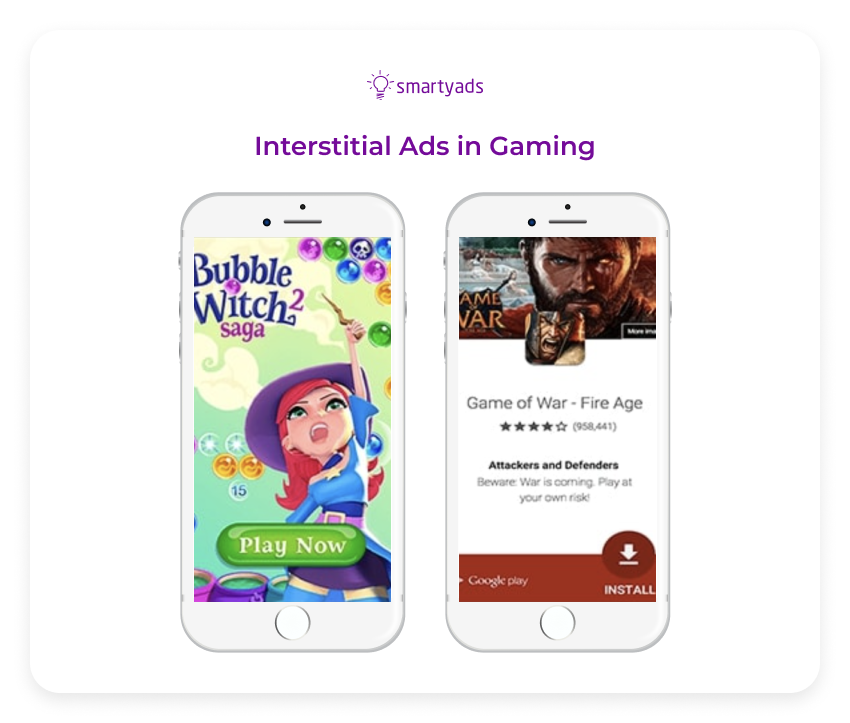
Interstitial Ads on Websites
Websites use interstitial banner ads to promote newsletter sign-ups, special offers, or featured content. When you visit a news site, you might encounter an interstitial ad for a premium subscription before accessing articles.
Many websites leverage interstitials to encourage visitors to subscribe to their newsletters. As you browse a blog or news website, you may encounter a full-screen interstitial prompting to enter your email address in exchange for the latest updates, articles, or exclusive offers.
This approach helps websites build subscriber lists and inform readers about new content.
For example, when visiting The New York Times website, you may encounter an interstitial ad encouraging you to subscribe to their premium digital content. This ad highlights the benefits of subscription, including full access to their articles and exclusive features.
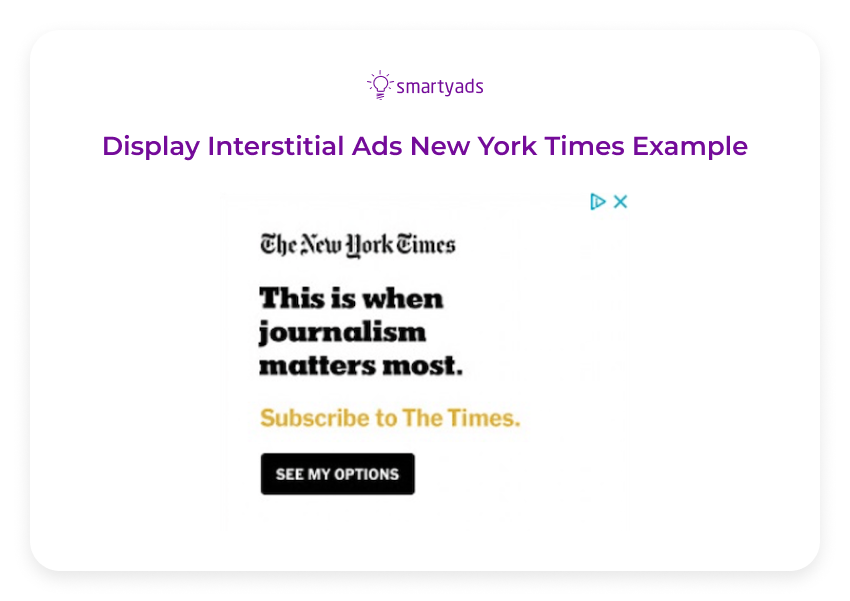
Interstitial Ads on Social Media
Instagram incorporates interstitial ads into users' stories. These immersive, full-screen ads can promote fashion brands or travel destinations.
Interstitial Ads on Social Media are a compelling way to engage users within the realms of their favorite platforms. These ads have gained prominence on various social media networks, offering users a unique and immersive experience.
One prominent example of Interstitial Ads on Social Media is Instagram Stories. Instagram has seamlessly integrated interstitial ads within the Stories feature. These full-screen ads provide a captivating and immersive way to connect with users. Brands often use these ads to promote various products and services.
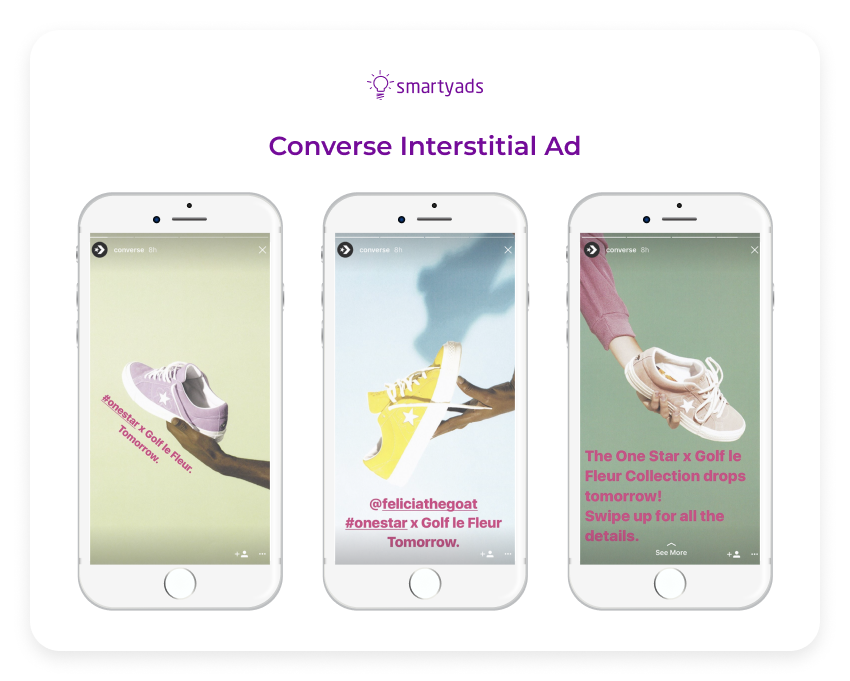
Snapchat
On Snapchat, the Discover feature incorporates Interstitial Ads to deliver engaging content. These ads can include interactive elements like games, quizzes, or augmented reality experiences. Brands use these ads to create a sense of immersion and interaction.
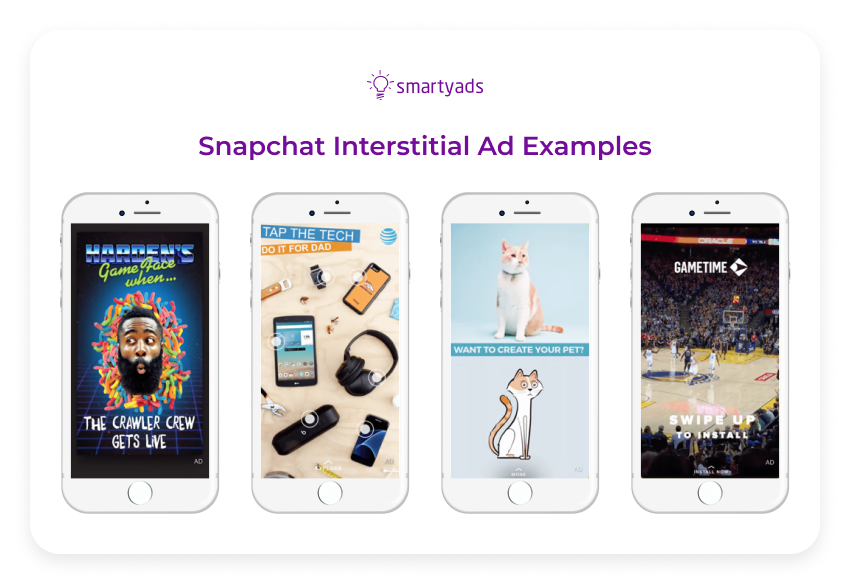
Interstitial Ads in Email
Email marketing employs interstitials as pop-up ads to announce webinars or exclusive promotions. For instance, a clothing retailer may use interstitial pop-up ads to showcase a limited-time sale.
Interstitial Ads in Email marketing have emerged as a dynamic tool to captivate the attention of readers within the realm of their inboxes.
This innovative approach adds a layer of interaction to email campaigns, effectively promoting webinars, exclusive offers, or other compelling content. Let's delve into the world of Interstitial Ads in Email and explore how they are creating a buzz in the digital marketing landscape.
E-commerce retailers find Interstitial Ads in Email particularly effective for promoting limited-time sales and exclusive offers. These interstitial pop-up ads can inform subscribers about special discounts or flash sales.
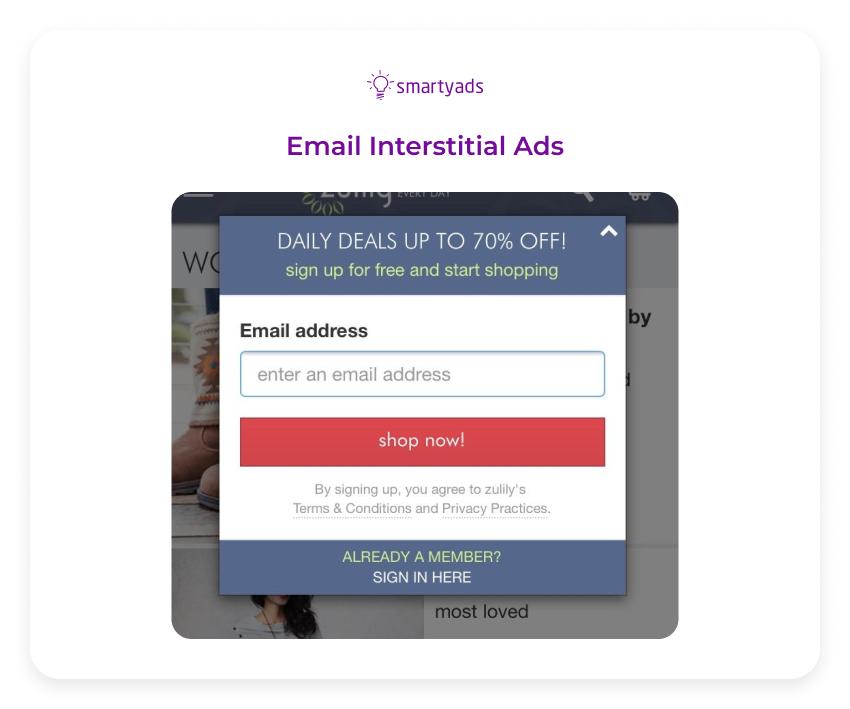
Interstitial Ads in Streaming Services
Interstitial Ads in Streaming Services have become a common sight for users indulging in their favorite TV series or movies. Streaming platforms, including heavyweights like Hulu and Netflix, strategically incorporate video ads to generate revenue and promote premium content or sponsors.
Though occasionally frustrating, these ad interruptions play an essential role in sustaining the availability of high-quality content on streaming services.
Interstitial video ads on streaming services are often used to highlight premium or exclusive content available on the platform.
For instance, if a streaming service has recently released a highly anticipated show or film, it may insert an interstitial ad that teases the content's storyline and showcases compelling snippets. This approach serves a dual purpose: it generates excitement among viewers and encourages them to watch the promoted content.
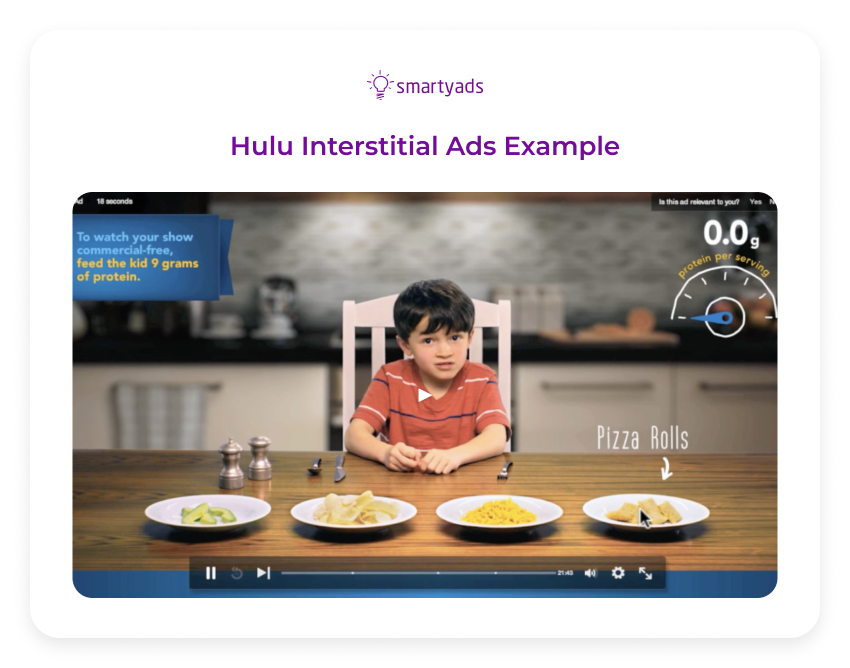
Streaming platforms employ advanced algorithms to manage the frequency and relevance of interstitial video ads. These algorithms consider user behavior, content preferences, and viewing history to ensure that ads are not overly intrusive and remain engaging.
Bottom line
In the captivating world of interstitial ads, examples abound to inspire and engage. With programmatic powerhouses like SmartyAds DSP and SmartyAds SSP, advertisers unlock the potential for seamless integration and precise targeting. So, whether you're weaving compelling narratives on streaming platforms or sparking curiosity on social media, the synergy of interstitial ads and programmatic platforms paves the way for your digital success.
Run interstitial ads with SmartyAds DSP and place interstitial ads on your platform with SmartyAds SSP!
FAQ
Interstitial ads are dynamic promotional content that appears between natural transitions in digital media, such as webpage or app transitions. These full-screen ads capture users' attention during moments like loading screens, page changes, or video transitions. Interstitial ads can include static images, videos, or interactive elements, offering advertisers valuable opportunities to engage their audience in a visually impactful manner.
The choice of interstitial ad format depends on your specific business objectives. Full-screen interstitials can be effective for immersive brand experiences, while interactive interstitials encourage user engagement. Select the format that best aligns with your campaign goals, considering factors like user experience and the message you want to convey.
Interstitial ad revenue varies widely based on factors such as ad quality, niche, user engagement, and ad placement. Generally, these ads can offer competitive rates, especially when they're well-targeted and provide value to users. Payouts can range from a few cents to several dollars per click or view, depending on the specifics of your campaign and the advertising platform.
